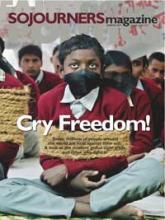A dark facet of diamonds has been illuminated in the film Blood Diamond starring Leonardo DiCaprio and Djimon Hounsou. One large diamond is the focus of an intense action plot involving kidnapping, torture, and slave labor. A desperate search unites a greedy diamond smuggler (DiCaprio) and a traumatized father (Hounsou) in search of his young son who is kidnapped by rebels and forced to become a child soldier.
Sadly, "blood diamonds" are not Hollywood fiction, but a very real source of currency fueling bloody conflicts in Africa. Blood diamonds—or conflict diamonds—are diamonds mined to purchase weapons used to commit brutal acts of war and human rights abuses. Globally, their numbers have decreased: Currently, conflict diamonds are estimated to make up 1 percent of the global diamond market.
But if one diamond is enough to make one movie, imagine the impact of an entire mine run by ruthless militants?
As Blood Diamond portrays, during the 1990s diamond mines in Sierra Leone helped fund that nation's war and associated human misery. The Revolutionary United Front rebels wreaked havoc with a signature torture known as "long sleeves/short sleeves": hacking off the arms or hands of innocent civilians as a means of clearing the land in order to claim the mines. Children tragically played a large part in this conflict as rebels abducted thousands of children, some as young as 8, and brutalized them to become the frontline soldiers. The chaos of war became the cover to engage in profitable trade. While the diamond industry wants consumers to believe the film is mere history, the reality is that today conflict diamonds help to sustain war in various countries and a widespread humanitarian crisis in the Democratic Republic of the Congo.
Read the Full Article
